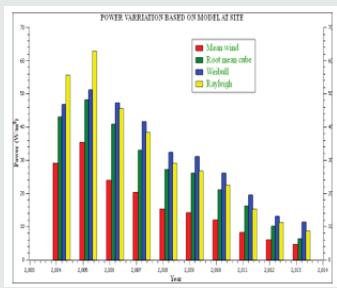
Lupine Publishers Group
Lupine Publishers
Menu
ISSN: 2641-6794
Mini Review2641-6794 
Effect of Global Warming on Wind Energy Volume 3 - Issue 4
Ongaki N Laban*
- Department of Physics, KISII University, Kenya
Received: August 15, 2019; Published:August 22, 2019
Corresponding author:Ongaki N Laban, Department of Physics, KISII University, Kenya
DOI: 10.32474/OAJESS.2019.03.000167
Abstract
Global warming is a growing threat in the world today mainly due to emission of CO2 which comes as a result burning of fossil fuels. As result, countries have been forced to find new ways of generating electricity which is clean and environmentally friendly. Wind stands a better chance to mitigate this gap. But it is emerging that, wind also is under the threat of global warming as various studies shows a worrying trends of wind power decrease over years. In this research, evidence of reduced wind power over years is presented.
Keywords: Wind power; Global Warming
Introduction
The cost of energy has a significant impact on the economy of any country in the world. It is to be noted that, activities that are energy in- tense like cement, paper, steel and pulp de- pends greatly on the cost of energy. This implies that, as the prices of energy goes high, then domestic wealth creation, job creation and balance of payments gets impacted negatively as consumers tends to opt for cheaper imports. The serious challenge that is facing energy in the world as at the moment is population growth. Developing countries like Kenya have uncontrolled birth rates and hence high population growth rates. Due to this, there is high need by governments of these countries to offer their population the opportunity to consume fossil fuel products though it is discouraging to note that the global oil supply is not enough to sustain an overpopulated planet. This has an implication that, in future, the world’s economic dependence of fossil fuel will continue to hike if other alternative sources of energy generation will not be exhausted. Also, it should be noted that, the oil and gas in the ground, even if enough, will not last forever.
Most developing countries in the world experiences frequent power outages due to overreliance on electricity generation from hydropower and geothermal power plants. You find that, during droughts and prolonged dry seasons, this hydrological and geothermal source become overstretched hence making the countries to face electric power shortages some- thing which makes them to resort to power rationing. As a way to solve this menace, various stop gap measures have been adopted such as the use of fuel generators as backups on a smaller scale, solar energy is currently being used to power standalone areas and street lighting as well as, biogas and wind energy.
During the adoption of fuel generators as power backups, the fuels are burnt thus producing harmful emissions to the environment. Of the gases emitted, it is estimated that about 80% of them contribute to greenhouse effect of the atmosphere. To reduce overreliance on generators as backups during power outages, alternative sources of energy like wind need be investigated to help back up electricity generation. Though wind stands a chance to solve this problem, lack of site’s adequate wind profile to enable informed choice on whether to invest in wind as energy source is still a challenge. Various researchers are working on various wind power projects so as to establish wind profiles that will help investors to make informed choice on whether to invest on the resource as an alternative source of power and if yes, to help them in the selection of the best machine which can fit a given wind regime for optimum production of energy.
In the assessment of wind resource, wind speed and wind direction are key characters that are investigated and the factors affecting them. As at far, it has been established that, wind speed and direction changes frequently due to turbulence of air flow and under the influence of the external factors caused by spatial and temporal non-uniformity of temperature and pressure in various parts of the atmosphere. In addition, it is also caused by the geographical nature of the terrain and surface roughness of a place.
Results and Discussions
Figure 1 shows wind power distributions of Kisii region based on four methods of prediction (Source: Preprints 2018, 2018100256 (doi:10.20944/preprints201810.0256.v1). The trend in the figure is what worries. The wind speeds of this site are in a reducing trend be- tween 2004 and 2013. Various theories and phenomenon might be used to explain the trend, but it should be noted that climatic changes have a role to play in the trend.
In concluding his research “A Statistical Analysis of Wind Speed and Power Density Based on Weibull and Rayleigh Models of Jumla, Nepal” Ayush P., 2016 notes that there is a decreasing trend in yearly & monthly wind speed in Jumla between year 2004 to 2013 and emphasises that the effect is due to global climate change. Figure two is a figure for Jumla wind power between 2004 and 2014. (Source:DOI:10.4236/epe.2016.87026,
https://www.researchgate.net/publication/306406 852).
(Figure 2) This analysis reveals that, if this trend of wind power continues and in any case holds waters, then huge amount of costs are going to be rendered useless since countries have invested billions of money to establish wind power firms with expectations that they will last for an unforeseeable future something which might turn out to be untrue. According to this research, a decreased wind power production has to be expected in the future from diurnally to annually time scales. And if this happens, then it means that, a lot of investments are going to a waste. For instance, Kenya recently launched a 310MW wind power project in the Northern eastern parts of Kenya with high expectations that it is going to add a good input to its national grid which will serve its citizens in a foreseeable future. What will happen if the trend is true in the northern eastern where this firm is locate if the trend holds there.
So, according to projections, if climate change is affecting wind power production or is the main cause of this trend in any way, then, mitigation measures need to be put in place in order to reduce the billions of common mwananchi’s tax which is going to rendered useless due to this projects. Also, in conclusion, it is high time climate change deniers accept the reality and see the impact it will cause to the future generation and start acting immediately.

Top Editors
-

Mark E Smith
Bio chemistry
University of Texas Medical Branch, USA -

Lawrence A Presley
Department of Criminal Justice
Liberty University, USA -

Thomas W Miller
Department of Psychiatry
University of Kentucky, USA -

Gjumrakch Aliev
Department of Medicine
Gally International Biomedical Research & Consulting LLC, USA -

Christopher Bryant
Department of Urbanisation and Agricultural
Montreal university, USA -

Robert William Frare
Oral & Maxillofacial Pathology
New York University, USA -

Rudolph Modesto Navari
Gastroenterology and Hepatology
University of Alabama, UK -

Andrew Hague
Department of Medicine
Universities of Bradford, UK -

George Gregory Buttigieg
Maltese College of Obstetrics and Gynaecology, Europe -

Chen-Hsiung Yeh
Oncology
Circulogene Theranostics, England -
.png)
Emilio Bucio-Carrillo
Radiation Chemistry
National University of Mexico, USA -
.jpg)
Casey J Grenier
Analytical Chemistry
Wentworth Institute of Technology, USA -
Hany Atalah
Minimally Invasive Surgery
Mercer University school of Medicine, USA -

Abu-Hussein Muhamad
Pediatric Dentistry
University of Athens , Greece

The annual scholar awards from Lupine Publishers honor a selected number Read More...






